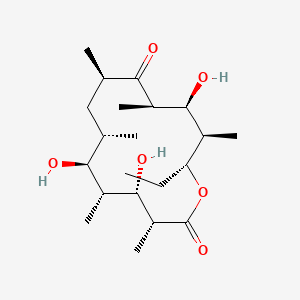| Authors | Title | Published | Journal | PubMed Link |
|---|---|---|---|---|
| Kapur S et al. | Molecular recognition between ketosynthase and acyl carrier protein domains of the 6-deoxyerythronolide B synthase. | 2010 | Proc. Natl. Acad. Sci. U.S.A. | pmid:21127271 |
| Wu J et al. | Construction and performance of heterologous polyketide-producing K-12- and B-derived Escherichia coli. | 2010 | Lett. Appl. Microbiol. | pmid:20565574 |
| Donadio S et al. | Modular organization of genes required for complex polyketide biosynthesis. | 1991 | Science | pmid:2024119 |
| Zhang H et al. | Investigating the role of native propionyl-CoA and methylmalonyl-CoA metabolism on heterologous polyketide production in Escherichia coli. | 2010 | Biotechnol. Bioeng. | pmid:19806677 |
| Khosla C | Structures and mechanisms of polyketide synthases. | 2009 | J. Org. Chem. | pmid:19711990 |
| Pistorino M and Pfeifer BA | Efficient experimental design and micro-scale medium enhancement of 6-deoxyerythronolide B production through Escherichia coli. | 2009 Sep-Oct | Biotechnol. Prog. | pmid:19634176 |
| Keatinge-Clay A | Crystal structure of the erythromycin polyketide synthase dehydratase. | 2008 | J. Mol. Biol. | pmid:18952099 |
| Wang Y and Pfeifer BA | 6-deoxyerythronolide B production through chromosomal localization of the deoxyerythronolide B synthase genes in E. coli. | 2008 | Metab. Eng. | pmid:17959404 |
| Wang Y et al. | Improving heterologous polyketide production in Escherichia coli by overexpression of an S-adenosylmethionine synthetase gene. | 2007 | Appl. Microbiol. Biotechnol. | pmid:17876579 |
| Sharma KK and Boddy CN | The thioesterase domain from the pimaricin and erythromycin biosynthetic pathways can catalyze hydrolysis of simple thioester substrates. | 2007 | Bioorg. Med. Chem. Lett. | pmid:17428661 |
6-deoxyerythronolide B
6-deoxyerythronolide B is a lipid of Polyketides (PK) class. The involved functions are known as Anabolism, Biosynthetic Pathways and Synthesis. The associated genes with 6-deoxyerythronolide B are LARGE gene. The related lipids are Propionate.
Cross Reference
Introduction
To understand associated biological information of 6-deoxyerythronolide B, we collected biological information of abnormalities, associated pathways, cellular/molecular locations, biological functions, related genes/proteins, lipids and common seen animal/experimental models with organized paragraphs from literatures.
What diseases are associated with 6-deoxyerythronolide B?
There are no associated biomedical information in the current reference collection.
No disease MeSH terms mapped to the current reference collection.
PubChem Associated disorders and diseases
What pathways are associated with 6-deoxyerythronolide B
Lipid pathways are not clear in current pathway databases. We organized associated pathways with 6-deoxyerythronolide B through full-text articles, including metabolic pathways or pathways of biological mechanisms.
Related references are published most in these journals:
| Pathway name | Related literatures |
|---|
PubChem Biomolecular Interactions and Pathways
Link to PubChem Biomolecular Interactions and PathwaysWhat cellular locations are associated with 6-deoxyerythronolide B?
There are no associated biomedical information in the current reference collection.
What functions are associated with 6-deoxyerythronolide B?
Related references are published most in these journals:
| Function | Cross reference | Weighted score | Related literatures |
|---|
What lipids are associated with 6-deoxyerythronolide B?
Related references are published most in these journals:
| Lipid concept | Cross reference | Weighted score | Related literatures |
|---|
What genes are associated with 6-deoxyerythronolide B?
Related references are published most in these journals:
| Gene | Cross reference | Weighted score | Related literatures |
|---|
What common seen animal models are associated with 6-deoxyerythronolide B?
There are no associated biomedical information in the current reference collection.
